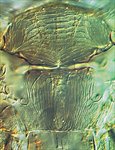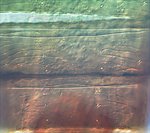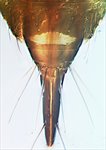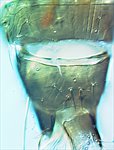
dentatus meso & metanota

dentatus tergites IV-V

dentatus tergites VIII-X

dentatus male tergites VIII-IX
Generic diagnosis
Female macropterous. Head as wide as long; maxillary palps 3-segmented; eyes without pigmented facets; ocellar setae pair I present; setae III no longer than length of an ocellus and arising posterior to the tangent to the posterior ocelli; five pairs of short postocular setae but not in a straight row. Antenna 8-segmented; III and IV with sense cones forked but short and very stout; III–VI with microtrichia on both surfaces. Pronotum without sculpture medially, setae all small, except posteromarginal setal pair V twice as long as discal setae. Mesonotum transversely reticulate, median setae near posterior margin; anteromedian campaniform sensilla present. Metanotum with longitudinal sculpture, median setae small and at anterior margin; campaniform sensilla present near posterior margin. Fore wing first and second veins with setal rows complete, but setae wider apart than their length; clavus with four veinal and one discal setae; posteromarginal fringe cilia wavy. Prosternal ferna not divided; basantra membranous, without setae; prospinasternum broadly transverse. Mesosternal furca with spinula; metasternal furca without spinula. Tarsi 2-segmented, fore tarsus with ventro-apical curved tooth. Tergites II–VII without craspeda, but VIII concave posterior margin with row of translucent triangular teeth; VI–VIII with campaniform sensilla close to posterior margin; VIII with ctenidium-like row of microtrichia antero-lateral to spiracles, VII with weak ctenidium-like row of microtrichia terminating at tergal setae S3; IX with anterior campaniform sensilla present; X elongate with complete split. Sternites III–VI with three pairs of marginal setae, II with two pairs, all arising at margin.
Male similar to female; tergite IX with median setal pair prominent, one pair of very short stout setae postero-medially.
Biological data
Presumably living in flowers, and possibly associated with Asteraceae (zur Strassen, 2003).
Distribution data
Of the two species in this genus, one is known only from the eastern Mediteranean, but the type species, dentatus, is more widespread in southeastern Europe (zur Strassen, 2003). A single female taken from wheat at Jinan, Shandong Province, China was identified as this species (Mirab-balou, 2012). However, the illustrated terminal abdominal segments of that specimen are apparently different from the female illustrated here from Slovakia.
Nomenclatural data
Pseudoxythrips Priesner, 1940: 51. Type species Oxythrips dentatus Knechtel 1923, by monotypy.
Two species are recognised in this genus (ThripsWiki, 2020), and one of these is recorded from China:
dentatus (Knechtel, 1923: 123). (Oxythrips)
Relationship data
Thripidae sub-family Thripinae: this is a diverse group involving more than 230 genera. Relationships of Pseudoxythrips are obscure. The presence and position of ctenidium-like structures on tergites VII and VIII, together with some of the other character states, suggest a relationship to the Frankliniella group. However, the presence of a single pair of major setae on the pronotum has been interpreted as indicating a relationship to Oxythrips as one of the 40 genera of anaphothripines (Masumoto & Okajima, 2017).
References
Masumoto M & Okajima S (2017) Anaphothrips genus-group: key to world genera, with two new species and three new records from Japan (Thysanoptera, Thripidae). Zootaxa 4272 (2): 201–220.
Mirab-balou M, Wei SJ, Lu H & Chen XX (2012) Description of a new grass-living species of the genus Yoshinothrips Kudo, and a newly recorded genus of Thripinae for China (Thysanoptera: Thripidae). Acta Zootaxonomica Sinica 37 (2): 345–349.
ThripsWiki (2020). ThripsWiki - providing information on the World's thrips. <http://thrips.info/wiki/Main_Page>
zur Strassen R (2003) Die terebranten Thysanopteren Europas und des Mittelmeer-Gebietes. Die Tierwelt Deutschlands 74: 1–271.